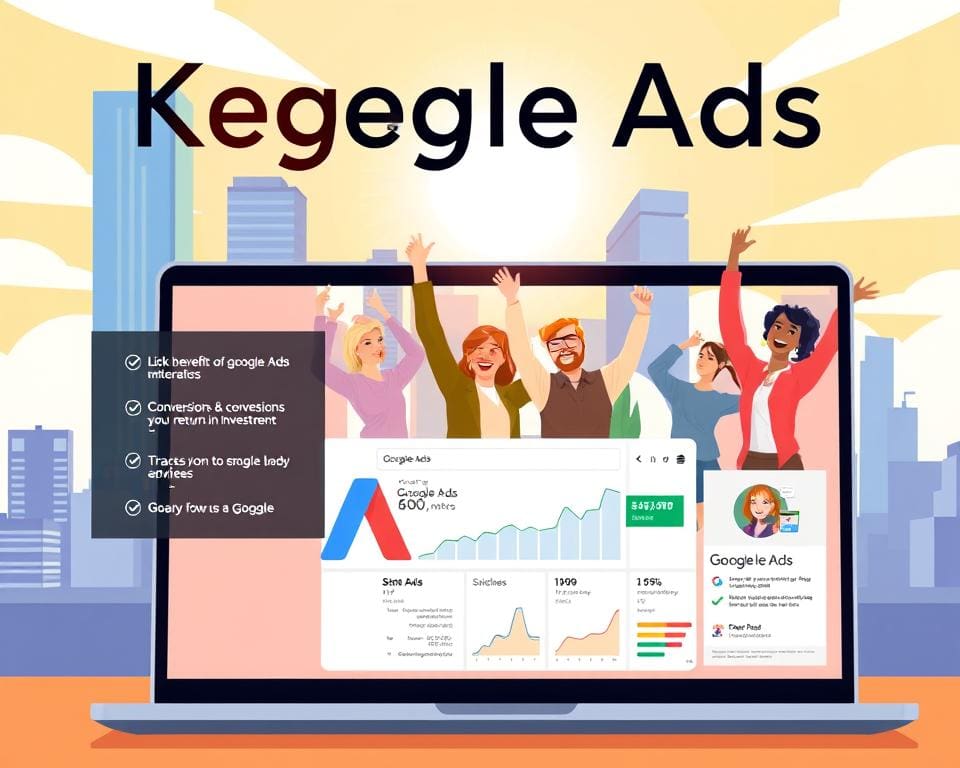In today’s competitive digital landscape, businesses must find effective ways to attract and engage potential customers. This is where Google Ads comes into play, offering unparalleled opportunities for visibility. By leveraging Google Ads, companies can present their products or services directly to users actively searching for them, which underscores the importance of understanding Why Use Google Ads. This platform not only enhances online presence but also helps in reaching marketing goals, making it a critical tool for driving conversions.
Understanding Google Ads and Its Functionality
Google Ads serves as a pivotal online advertising platform, developed by Google to empower businesses in promoting their products or services effectively. This detailed overview provides valuable insights into the functionality of Google Ads, illustrating how it operates and its capabilities for advertisers.
What is Google Ads?
Google Ads is a powerful tool that allows advertisers to bid on specific keywords relevant to their offerings. When users search for these keywords on Google, relevant adverts appear alongside organic search results. Advertisers can create diverse formats of ads, ensuring wide reach across Google’s extensive advertising network.
How Google Ads Works
The core of Google Ads functionality revolves around an auction system. Advertisers set bids for keywords, and the combination of bid amount and quality score—as determined by ad relevance and performance—ultimately establishes ad rank. This ranking is crucial in determining which adverts will be displayed, ensuring that the most relevant and engaging ads reach potential customers. Understanding this system enhances one’s grasp of Google Ads overview, enabling businesses to optimise their marketing strategies efficiently.

Why Use Google Ads for Businesses
Harnessing the power of Google Ads for businesses offers remarkable advantages, particularly in effectively targeting a specific audience. This platform provides tools that can segment potential customers based on their demographics, interests, and behaviours. These capabilities empower businesses to communicate more efficiently with those most likely to engage with their products or services.
Targeting Your Audience Effectively
Businesses can utilise Google Ads to create tailored campaigns that resonate with their targeted audience. By leveraging data insights, companies can focus on the right market segments, ensuring that advertising efforts are concentrated where they count the most. The ability to customise ads based on user characteristics allows brands to improve both relevance and engagement, fostering meaningful connections with potential customers.
Reaching Potential Customers at the Right Time
Timing in advertising plays a crucial role in maximising conversion opportunities. Google Ads allows businesses to deliver advertisements precisely when customers actively search for related products or services. This strategic placement of ads significantly enhances the likelihood of attracting interested buyers. With the opportunity to reach audiences at pivotal moments in their buying journey, companies can wield considerable influence over purchasing decisions.
Google Ads Benefits for Marketing Strategies
Integrating Google Ads into marketing strategies offers distinct advantages that can propel a business to new heights. By leveraging Google Ads, organisations can experience a marked increase in brand visibility and achieve swift traffic generation.
Boosting Brand Visibility
With Google Ads, businesses benefit from *enhanced brand visibility*. This platform enables effective targeting of specific audiences, ensuring that potential customers encounter your brand precisely when it matters. When ads appear at the top of search results, they capture user attention, fostering an immediate connection with those seeking relevant products or services.
Generating Immediate Traffic
Another significant advantage of Google Ads lies in its *traffic generation capabilities*. Ads can drive a substantial number of visitors to your website almost instantly. This immediate influx of traffic not only increases the likelihood of obtaining customer inquiries but also boosts overall engagement with your offerings.
Google Ads Advantages Over Other Platforms
Google Ads stands out as a premier choice for advertisers seeking to leverage the power of data-driven marketing. The platform offers various features, making it a leading option for enhancing campaign effectiveness. With its robust analytics tools, businesses can gain profound insights into their advertising performance, leading to improved strategies. The following explores key advantages that set Google Ads apart from its competitors.
Robust Analytics and Reporting Tools
One of the remarkable Google Ads advantages is its advanced analytics capabilities. Advertisers can access detailed reports that break down essential metrics such as click-through rates, conversion rates, and average cost-per-click. These analytics tools empower businesses to track their campaigns in real-time, facilitating swift adjustments and informed decision-making. In an era where data is crucial, these insights can significantly influence marketing strategies, ensuring that resources are allocated effectively.
Optimisation Capabilities for High ROI
The optimisation features within Google Ads are designed to enhance Return on Investment (ROI) for advertisers. By continuously monitoring campaign performance, Google Ads allows marketers to adjust budgets, bids, and ad placements based on real-time data. This proactive approach to optimisation for ROI ensures that marketing dollars yield the best possible returns. Advertisers can refine their strategies, target more precisely, and improve their overall marketing performance, all through the powerful tools available in Google Ads.
Crafting an Effective Google Ads Campaign
Creating a successful Google Ads campaign requires a strategic approach that aligns with your business objectives. Setting clear campaign goals is the first step in this process. Goals might range from increasing sales to enhancing brand awareness or driving more website traffic. By defining these objectives, you establish a focus that guides every aspect of your campaign.
Defining Campaign Goals
Establishing specific, measurable campaign goals can significantly enhance the effectiveness of your Google Ads campaign. Objectives should be realistic and attainable, allowing you to measure your progress consistently. For instance, aims could include achieving a particular number of leads, boosting website visits by a certain percentage, or increasing sales figures within a defined timeframe.
Choosing the Right Keywords
Effective keyword selection plays a critical role in the success of your campaign. Keywords should reflect not only what your business offers but also the search intent of your target audience. Researching relevant keywords helps ensure that your ads appear in appropriate search results, increasing visibility and engagement. Employing tools like Google Keyword Planner can aid in identifying popular keywords and phrases relevant to your products or services.
Ad Creative Best Practices
The strength of your ad creative can make or break a Google Ads campaign. Ad copy should be compelling, clear, and targeted to resonate with your audience. High-quality visuals can capture attention quickly, while a strong call to action can motivate potential customers to click through. Always test different ad creatives to determine which ones yield the best performance, allowing you to refine and optimise your ads for greater impact.
Understanding Google Ads Targeting Options
Effective advertising hinges on reaching the right audience. Google Ads targeting offers a myriad of options to help businesses connect with potential customers more precisely. By employing various targeting strategies, advertisers can optimise their campaigns and achieve better results.
Types of Targeting: Geographic, Demographic, and More
Google Ads targeting can be categorised into distinct types, each serving a unique purpose. Geographic targeting enables businesses to customise their ads for specific locations, making it ideal for local marketing efforts. With this approach, companies can focus on areas where they expect higher engagement, significantly increasing the chances of conversion.
Similarly, demographic targeting allows for a tailored advertising experience, letting advertisers hone in on audiences based on age, gender, and interests. This level of personalisation ensures that the right message reaches the right people, enhancing the likelihood of capturing their attention.
Utilising Remarketing Strategies
Remarketing strategies feature prominently in Google Ads targeting options, offering businesses the opportunity to reconnect with users who have previously interacted with their website. This targeted approach reminds potential customers of their interest, encouraging them to revisit and complete their purchase. By employing remarketing, businesses use data-driven insights to create personalised ads that resonate with those who are already familiar with their brand.
Google Ads Conversion Tracking Explained
Understanding the mechanisms behind Google Ads conversion tracking is essential for maximising your advertisement effectiveness. By establishing a robust conversion setup, businesses can tap into valuable insights that drive better decision-making. This section focuses on how to set up conversion tracking and interpret the resulting performance data for optimised campaign strategies.
Setting Up Conversion Tracking
To leverage Google Ads conversion tracking, begin by defining what actions you consider valuable for your business. Common conversions include purchases, sign-ups, and downloads. Navigate to your Google Ads account and follow the straightforward steps to create a conversion action. Ensure you integrate the provided tracking code onto your website to monitor these specific actions effectively.
Interpreting Conversion Data for Improved Performance
Once conversion tracking is established, analysing performance data becomes crucial. This information enables businesses to assess which advertisements are effectively driving desired actions. Examine conversion rates, cost per conversion, and return on ad spend. By interpreting this data accurately, you can adjust your campaigns, focusing on high-performing ads while revising or eliminating those that underperform.
Managing Your Google Ads Budget Efficiently
Effective Google Ads budget management is vital for ensuring your advertising campaigns not only run smoothly but also yield the best possible results. To start, setting a realistic budget that aligns with your overall campaign goals will help you to remain focused and mitigate unexpected costs. As you establish your budget, consider factors such as your marketing objectives and the average cost-per-click in your industry to gauge what is reasonable and achievable.
In the realm of budget optimisation, employing flexible bidding strategies can drastically influence the success of your campaigns. Google Ads offers automated budgeting features that allow you to allocate your funds dynamically based on performance and trends. This ensures that you are not only spending your budget wisely but also adapting to changing variables in the marketplace to drive cost-effective advertising.
Moreover, consistent monitoring of your expenditures is essential. By utilising analytical tools provided within Google Ads, you can track your spending in real-time and make necessary adjustments to maximise your returns. Remember, an informed approach to budget management will enhance your ability to achieve long-term success and ROI in your advertising efforts.









